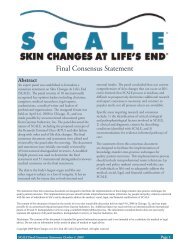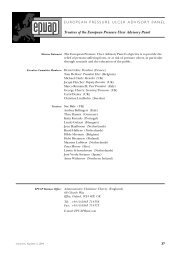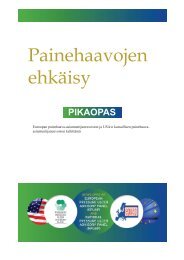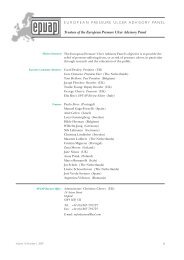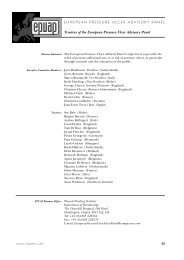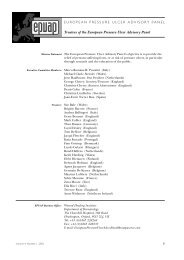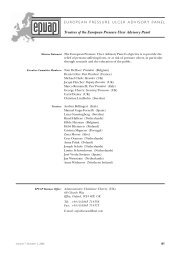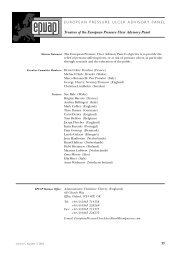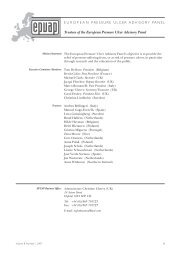EPUAP Review 5/2 RIP - European Pressure Ulcer Advisory Panel
EPUAP Review 5/2 RIP - European Pressure Ulcer Advisory Panel
EPUAP Review 5/2 RIP - European Pressure Ulcer Advisory Panel
Create successful ePaper yourself
Turn your PDF publications into a flip-book with our unique Google optimized e-Paper software.
• risk assessment<br />
• prevention<br />
• pressure ulcer assessment<br />
• treatment and complications<br />
• organizational issues and specific care-setting<br />
situations<br />
This structure was subsequently adopted during the development<br />
of the guideline.<br />
Search strategy<br />
Relevant literature was identified through a combination<br />
of searches of electronic data bases and hand-searching of<br />
reference lists and other available evidence-based guidelines.<br />
The electronic search covered four key data-bases –<br />
the Cochrane Library, CINAHL, EMBASE and MEDLINE.<br />
Each data-base was searched using the following key-words;<br />
pressure ulcer, pressure ulcers, pressure sore, pressure sores<br />
and decubitus. Studies retrieved with the last key-word were<br />
rejected from the review if they referred to the decubitus<br />
position. The search was refined using a variety of study<br />
designs as additional key-words; randomized clinical trials,<br />
cohort studies, retrospective studies, prospective studies,<br />
case control studies and case studies. Eligible studies had<br />
to be published between 1992 until July 2001. Members of<br />
the working group also submitted publications out with<br />
those included on the electronic data-bases while further<br />
publications were identified from reference lists and other<br />
evidence-based guidelines. In total over 400 publications<br />
were considered in this review. Each publication was then<br />
reviewed and graded using the following criteria:<br />
Where publications reported the use of interventions for<br />
either pressure ulcer prevention or treatment;<br />
A1 systematic reviews that included some studies of<br />
A2 level, with consistent results across the individual<br />
studies,<br />
A2 appropriately designed and conducted<br />
randomized controlled trials,<br />
B low quality randomized controlled trials or nonrandomized<br />
comparative cohort studies or<br />
patient-controlled studies,<br />
C non-comparative studies,<br />
D expert opinion.<br />
And in cases where publications reported upon diagnostic<br />
procedures for example risk assessment;<br />
A1 several prospective studies (including some at A2<br />
level) with minimal loss to follow-up within<br />
specified patient groups that reported clinical<br />
outcomes achieved after implementing a specified<br />
diagnostic procedure,<br />
A2 studies comparing the results from a diagnostic<br />
procedure against previously agreed ‘gold standard’<br />
reference procedure, with appropriate<br />
statistical analyses,<br />
B studies comparing the results from a diagnostic<br />
procedure against a reference procedure, may not<br />
have appropriate statistical analyses,<br />
C non comparative studies,<br />
D expert opinion.<br />
Throughout the process of reviewing and grading studies<br />
the working group would like to thank the Belgian <strong>Pressure</strong><br />
<strong>Ulcer</strong> Guideline Committee for the assistance they provided.<br />
Having graded the sources of evidence, the recommendations<br />
in the new guideline were also weighted as follows:<br />
1 Recommendation based on one systematic review<br />
(A1), or at least two independent studies on level A1<br />
or A2,<br />
2 Based on at least two independently executed studies<br />
on level B,<br />
3 Based on one study at level A2 or B, or studies on<br />
level C,<br />
4 Based on expert opinion.<br />
Each recommendation is supported by its scientific basis,<br />
representing a summary of the studies that underpin<br />
the recommendation. The key studies and weighting (level<br />
1 to 4) are illustrated for each of the given recommendations.<br />
Where recommendations were in part based on information<br />
outside the scientific studies (for example patient<br />
preferences, cost, equitable access throughout all care<br />
settings) the non-scientific aspects are listed as ‘other considerations’.<br />
Adopting this procedure for presenting recommendations<br />
was considered to increase the transparency<br />
and implementation of the guideline while also facilitating<br />
discussion within the working group!<br />
Legal implications of the guideline<br />
Clinical guidelines are not laws, but rather offer insights<br />
based on the available evidence that would assist caregivers<br />
to deliver ‘good’ care. These insights are based on the average<br />
or typical patient and when faced with a heterogeneous<br />
patient population it is likely that caregivers may exercise<br />
their professional judgement and decide to deviate from<br />
the guideline. Such deviations should be noted in the patients<br />
medical record.<br />
Updating the guideline<br />
NEWS FROM THE NETHERLANDS<br />
The CBO will update the guideline no later than 2007 although<br />
earlier review may be required dependent upon<br />
advancves in scientific knowledge and clinical practices.<br />
References<br />
1. Gezondheidsraad: Decubitus.Den Haag: Gezondheidsraad,<br />
1999. Publicatie nr 1999/23, blz.13.<br />
2. Bours, G. and Halfens R. ‘Decubitus komt nog veel te<br />
veel voor.’ TVZ 1999; (20): 608–611.<br />
3. Hey, S. <strong>Pressure</strong> sores care and cure (letter). Lancet<br />
1996; 348: 1511.D<br />
4. Haalboom JRE. <strong>Pressure</strong> <strong>Ulcer</strong>s. Lancet 1998; 352:<br />
581.<br />
5. Hu TW, Stotts NA, Fogarty TE and Bergstrom B. Cost<br />
analysis for guideline implementation in prevention<br />
and early treatment of pressure ulcers. Decubitus 1993;<br />
6: 42–46.<br />
6. Frantz R, Bergquist S and Specht J. The cost of<br />
treating pressure ulcers following implementation of<br />
a research-based skin care protocol in a long term<br />
Volume 5, Number 2, 2003 65



